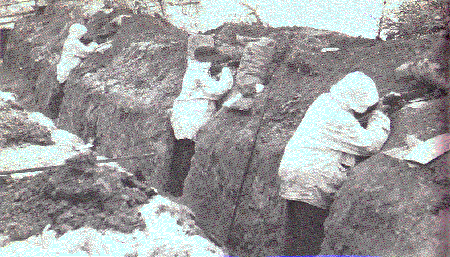


Around two hundred gun and machine gun positions and shelters for men were build of concrete. The strongest positions were in Summa area, which was considered the most threatening point of aggression. As the world situation deteriorated in the late 1930s, the building of the line was active, and volunteer fortification work was organized in summer 1939.
At the start of the Winter War, the Finnish troops settled in defence positions in December 1939. The defence line was then given the name Mannerheim Line in foreign press. It is said that a group of foreign journalists had visited the area during the autumn to get acquainted with the fortification work, and had asked the name of the chain of fortifications. In those days, there was a lot of talk about the French Maginot-line and the Siegfrid Line protecting the western border of Germany. A young officer, Jorma Gallen-Kallela, the son of Mannerheim’s ex-ADC, who was guiding the visitors had then come up with the name Mannerheim Line. After the outbreak of the Winter War the name appeared in some newspapers whose reporters had been among the visitors.
When the attack of the Soviet army halted at the Mannerheim Line for over two months, highly exaggerated descriptions of the line began to spread in the Soviet Union. It was compared to the Maginot Line, although it contained only four per cent of the amount of concrete device used in the Maginot-line. In practice, the German troops then moved around the Maginot Line in spring 1940. In February 1940, the Soviet troops succeeded in breaking through the Mannerheim Line near Summa by bombing it heavily. After the war the entire line remained in the area ceded to the Soviet Union.
After the beginning of the Continuation War in 1941, Mannerheim Line did not greatly obstruct the advancement of the Finnish troops, and there were no big battles on the line in connection of the great Soviet offensive in June 1944.
World War II | Pacific War | Winter War | Headquarters | Mannerheim Line | Vilho Petter Nenonen | K.L. Oesch | Harald Öhquist | Paavo Talvela | Continuation War |Transit Pact | Risto Ryti | Order of the Day of the Sword Scabbard | Erik Heinrichs | A.F. Airo | Hugo Österman | Marshal's Drink | Mannerheim Cross | Title of Marshal of Finland | Air War - Air Forces
COURSE OF LIFE | FAMILY | TIME OF GROWTH | MILITARY CAREER | WAR OF INDEPENDENCE | REGENT 1918-1919 | CIVILIAN | DEFENCE COUNCIL | COMMANDER-IN-CHIEF 1939-1946 | PRESIDENT OF THE REPUBLIC 1944-1946 | RETIREMENT | SPECIAL TOPICS | SEARCH